|


The Serious Freshening
Go to <Last, Summary, Next>
Engine—Valve Job
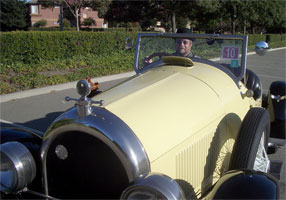
Lynn in Bugsby, September 5, 2005
|
Completed: 2006-04-14 — Started: 2005-12-27
|
INSIDE CYLINDERS:
Here's a view of the cylinders (cylinders #1-6, left to right)
after the removal of the head.
The "wet" appearance is due
to the oil that was injected during the compression test.
|
|
VALVE SEATS:
Here's a view of the valve seats (cylinders #1-6, left to right)
after the removal of most of the carbon and the valves.
Cylinders 3 & 4 share an exhaust manifold port. Cylinder 4 had the bad compression test.
Note that valve seat inserts have been installed, as clearly evident on the intake side of
cylinder #1 and the exhaust side of cylinder #3.
|
Work Completed:
The compression test that Lynn
performed during his initial freshening indicated that there was a serious problem with
cylinder #4 as its compression was significantly different (~20 PSI or ~40% low) compared
with the expected nominal value of about 54 PSI.
After removing the head and valves, Lynn is delighted to see that a former owner (thanks Bill Trollope?)
had hardened valve seat inserts installed.
However it's clear that a valve and seat resurfacing is needed.
While Lynn is prepared to do the resurfacing himself, he cannot locate a set of stones or other
resurfacing equipment.
Apparently current automotive practice is for precision and expensive equipment that is cost prohibitive
for a single resurfacing job.
The current expectation is that one should take your valve seats to a machine shop for refacing.
|
PULLING THE ENGINE:
For a machine shop to resurface the valve seats in Bugsby's motor, Lynn needs to remove the
motor from the car.
On the evening of Jan. 3, 2006, Lynn rents an engine lift and begins the final preparations
for removing the engine (left, about 09:00 PM).
By about 12:30 AM (center) the engine is lifted free, and by about 02:00 AM (left) the
engine is tied in the corner of the Beast for transport
to the machine shop later that morning.
|
With most modern engines, the valves are contained within the head, a reasonably small and portable
piece of hardware.
Unfortunately, the L-head motor in Bugsby has the valve seats in the main engine block.
It will be necessary to completely remove the engine from the car and transport it to a local machine
shop.
Lynn spends several days removing the auxiliary equipment from Bugsby.
On the evening of Jan. 3, Lynn swings by a local equipment rental and leases an engine lift.
Next morning, before going to work, Lynn drops the motor at
the machine shop at D&M Auto for a valve and seat
resurfacing.
|
DAN:
Dan indulges Lynn by posing for a picture. Dan is standing behind Bugsby's motor at the D&M Auto Parts
machine shop on Feb. 4.
|
|
RESURFACED VALVE SEATS:
Here's a view of the valve seats (cylinders #1-6, left to right)
after they've been resurfaced by Dan.
|
|
ENGINE ISSUES:
Dan notes an issue on the block between cylinders 3 & 4 (left) wherein the thin bridge of
metal that separates the exhaust valves has slumped by 0.003".
Dan also points out where previous cracks in the block around the exhaust
ports of cylinders 3 & 4 have been repaired by installation of special repair screws (center photo
above and right of "3", right photo just above and left of "E").
|
Dave Arnold had warned Lynn that it was common
for cracks to occur around the exhaust ports of cylinders 3 & 4.
The metal of the block forms a relative thin bridge over the chamber below these cylinders which
share a common port to the exhaust manifold.
According to Dave, this is why there are relatively few six cylinder speedsters still running.
After removing the head, Lynn felt confident that he didn't have any problems of this nature based
on his examination, but he didn't look closely enough.
When he finished his valve and seat resurfacing for Lynn, Dan points to a 0.003" "sag" in the
thin metal bridge separating the exhaust ports of cylinders 3 & 4.
Dan also shows Lynn where someone (thanks Bill Trollope?) had previously repaired cracks in the block around the
exhaust ports of cylinders 3 & 4.
It looks like Lynn has been lucky and the engine remains serviceable, but this region in the center
of the engine appears have a significant design weakness.
|
SHOP CRANE:
To support his engine work, Lynn buys a shop crane (left) that was on sale at Kragen.
This relatively inexpensive crane has worked well for Lynn so far.
In spite of the fact that the engine on Bugsby is very heavy, this crane has given Lynn good service,
shown unloading the engine (right) as it comes back from D&M.
|
|
VALVES REINSTALLED:
Valves and springs are reinstalled in the engine (left to right, cylinders 6 to 1 as viewed from right side of engine).
|
|
ADJUSTING VALVES:
Lynn adjusts valves (left), marks on timing gears (center) and feeler gauges (right).
|
|
FINAL ASSEMBLY:
Lynn finishes installing head and exhaust manifold (left),
top of engine after assembly (center) and polished valve covers with restored placard (right).
|
Work Remaining:
None.

Contact  with your comments or questions with your comments or questions
Copyright © 2018 Lynn Kissel
Last updated: May 24, 2009
|










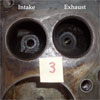

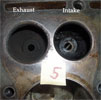
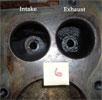
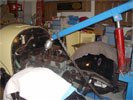
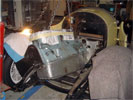
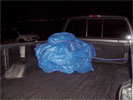

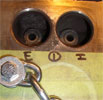


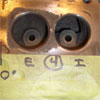


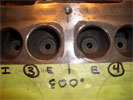

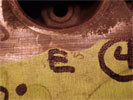


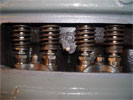
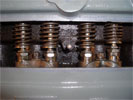
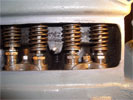





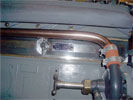
 with your comments or questions
with your comments or questions